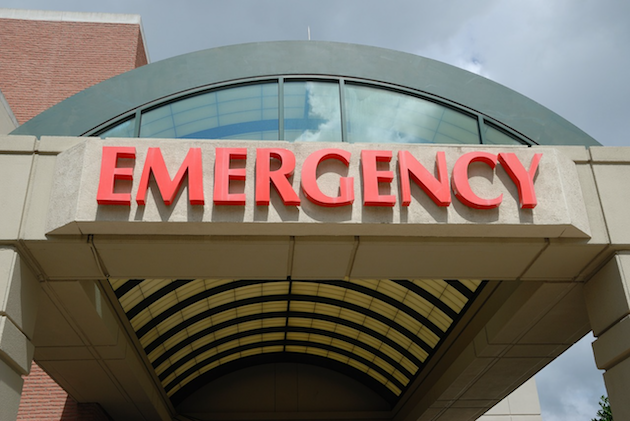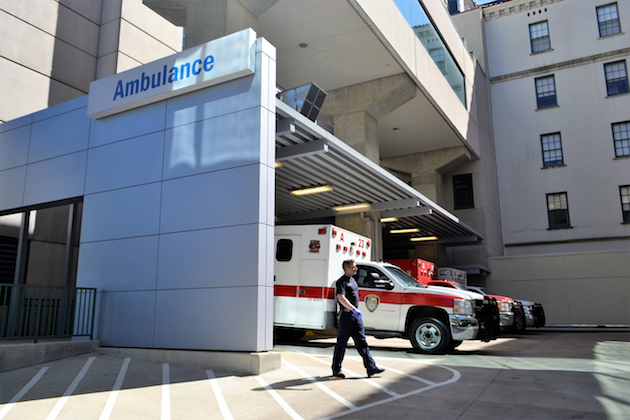My son’s first visit to the emergency room (ER) occurred when he was just a few months old. Our pediatrician had prepared us well, so when he spiked a fever, I knew exactly what to do. As a new mom, the number of “what ifs” can feel overwhelming. Having a list of emergent signs and symptoms to look out for including what to do about them helped me navigate those early years when the risk of illness and injury is highest. I recently had an opportunity to speak with Dr. Kenneth Kwon, director of pediatric emergency services and chief of staff at CHOC Children’s at Mission Hospital about how parents can know when it’s time to take their children to the emergency room.

This is part of a sponsored collaboration with CHOC Children’s.
Emergency Department at CHOC Children’s at Mission Hospital
CHOC Children’s at Mission Hospital is the only children’s hospital for families in south Orange County. CHOC Children’s at Mission Hospital is a separately licensed 54-bed “hospital within a hospital” on the fifth floor of Mission Hospital. Through CHOC’s partnership with Mission Hospital, families have access to pediatric expertise in the emergency room as well as a Level II pediatric trauma center.
As a parent and a health care provider, I recognize that kids have specific physical, emotional, and developmental needs. The emergency department at Mission Hospital was designed to meet those needs with a team of physicians and providers designed to treat each child that comes through the doors. This includes pediatric-centric equipment, facilities, waiting areas, and age-appropriate toys and videos. As stressful as a visit to the ER can be, CHOC’s family-centered care model ensures that the entire family is cared for in a way that is compassionate. Specifically, CHOC’s child life specialists help kids navigate their experience in the ER with distraction and coping techniques. CHOC also has a panel of specialists that can handle nearly any pediatric emergency.

When Should I Take My Child to the Emergency Room?
According to Dr. Kwon, there are 10 signs and symptoms that warrant emergency care.
- Fever in an infant under the age of 3 months. Fever in an infant under the age of 3 months may require blood, urine testing, and a lumbar puncture, which cannot be handled by an urgent care or a pediatrician’s office.
- Acute, altered level of consciousness. If your child is not acting normally or if the alteration in mental state is accompanied by head injury, headache, vomiting and/or fevers, parents should bring their child in to the ER.
- Significant breathing difficulties. Breathing difficulties are subjective, however, if that difficulty is accompanied by color changes or changes in behavior, it warrants emergency treatment.
- Bleeding that will not stop with pressure. A typical nose bleed or a cut will stop bleeding with pressure.
- Fractures with significant swelling or an obvious deformity. Any significant swelling or deformity may require reduction under sedation, which cannot be performed in an urgent care or a pediatrician’s office.
- Significant abdominal pain. Abdominal pain typically requires imaging and blood tests including an ultrasound and/or CT scan, none of which can typically be performed in an urgent care or doctor’s office.
- Vomiting. Vomiting is one of the most common reasons for ER visits. According to Dr. Kwon, significant vomiting that includes more than several episodes, or vomiting that lasts longer than one day, requires a visit to the ER because of the risk of dehydration. Additionally, any prolonged vomiting associated with headache, fever, and/or abdominal pain warrants an ER visit.
- Ingestions or suspected poisoning. When a child ingests a medication or substance that a parent is not about, an emergency visit is warranted. Additionally parents can contact their local Poison Control Center for guidance on further care.
- Seizures. Prolonged seizures have the ability to affect a child’s airway. Any child experiencing an active seizure or a prolonged seizure lasting more than a few minutes should be brought to the ER.
- Suicidal and/or homicidal thoughts or ideation. Any aggressive or violent behavior towards self or another cannot be handled in an urgent care or pediatrician’s office and requires an ER visit. These children may require restraints and referrals can be made to the appropriate resources.
Generally speaking, Dr. Kwon recommends an ER visit if the child will require blood tests or imaging studies since these services are not typically available at a physician’s office or an urgent care.
What Illnesses Can Be Treated in a Doctor’s Office?
According to Dr. Kwon, many childhood illnesses and/or injuries can be handled at an urgent care or a physician’s office.
- Fevers in children older than 3 months that last less than 3 days
- Minor cuts or lacerations
- Vomiting and diarrhea that is not prolonged or excessive
- Cough, cold, and/or flu-like symptoms
- Minor head injuries
- Minor trauma including burns and extremity injuries
- Small abcesses
- Suspected urinary tract infections in kids older than 3 months of age
- Earache and/or suspected ear infections
- Pink eye
- Minor breathing difficulties, particularly in children previously diagnosed with asthma
- Fractures without any obvious deformity or swelling
What is the Difference Between an Urgent Care and an Emergency Room?
According to Dr. Kwon, all urgent care centers are not created equal. Many Urgent Care Centers tend to have less regulations and standards than an emergency department. Some centers may have X-ray facilities and can be staffed by pediatricians. Other centers can be staffed by internists, family or emergency physicians, or even providers with extra training in the discipline of urgent care. Dr. Kwon’s advice to families is to look at your local urgent care to determine who is working there and what their credentials are before you need to visit. Additionally, if an urgent care near you specializes in pediatric medicine, it is encouraged to visit that center over a facility that doesn’t specialize in treating kids.
How Should Families of Children With Chronic Medical Conditions Approach Emergencies?
The most common pediatric chronic medical conditions seen in the ER include congenital heart disease, neurologic disorders, metabolic diseases, and cancers. Dr. Kwon’s best advice for families of children with chronic illness is to have a one-page typed written summary of the child’s medical condition, medications, and contact information for the physicians treating the child. Additionally, families are encouraged whenever possible to visit the emergency department their primary physician or specialist is affiliated with.
- Discover Luxury at Sonesta Irvine: Your Ideal Staycation - August 8, 2024
- CHOC Walk Returns to the Disneyland Resort – Special Events and Ways to Support - June 28, 2023
- Beastly Ball Returns to the Los Angeles Zoo - May 8, 2023



Leave a Reply